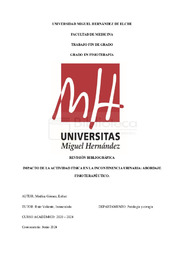Resumen :
Introducción: La incontinencia urinaria (IU) se define como la pérdida involuntaria de orina, y supone un problema para las mujeres que la padecen. Afecta en gran medida a aquellas que realizan deporte, siendo más común en aquellos que implican alto impacto. La fisioterapia, con un 70% de eficacia, fortalece el suelo pélvico por lo que promover la conciencia y el tratamiento es crucial para mejorar la calidad de vida y el rendimiento deportivo.
Objetivo: Verificar la relación entre la IU y la práctica deportiva, así como identificar enfoques fisioterapéuticos para su tratamiento, a través de la revisión de evidencia científica disponible.
Material y método: Se realizó una revisión bibliográfica en Cochrane Library, PEDro, Scopus y Pubmed seleccionando estudios transversales y ensayos clínicos de los últimos 14 años que incluyeran mujeres nulíparas deportistas jóvenes y de mediana edad.
Resultados: Se analizaron los resultados de 11 artículos que abordaban el impacto de la IU y de otros 8 que analizaban las diferentes técnicas fisioterapéuticas de tratamiento. Se aborda la eficacia de técnicas como la neuroacupuntura, el fortalecimiento de la musculatura, la reeducación, las contracciones reflejas y el biofeedback.
Conclusiones: La IU en mujeres deportistas afecta su calidad de vida y rendimiento constituyendo una preocupación común que impacta negativamente en su bienestar. Los tratamientos fisioterapéuticos como el entrenamiento del suelo pélvico han demostrado mejorar los síntomas. Es crucial abordar la IU de manera integral en todos los contextos.
Background: Urinary incontinence (UI) is defined as the involuntary loss of urine, and it represents a problem for women who suffer from it. It greatly affects those who pracctice sports, being more common in those that involve high-impact activities. Physiotherapy, with a 70% efficacy rate, strenghtens the pelvic floor, so promoting awareness and treatment is crucial to improve quality of life and sports performance.
Objective: To verify the relationship between UI and sports practice, as well as to identify physiotherapeutic epproaches for its treatment, through the review of avaliable scientific evidence.
Material and methods: A bibliographic review was carried out with systematic methodology in the PubMed, PEDro, Scopus and Cochrane Library databases. Cross – sectional studies and randomized clinical trials published in the last 14 years in spanish, english or portuguese were selected, focusing on nulliparous female athletes of young and middle age as the study subjects.
Results: We analyzed the results of 11 articles that addressed the impacto of urinary incontinence and another 8 that analyzed the different physiotherapeutic treatment techniques. The efficacy of techniques such as neuroacupuncture, muscle strenthening, reeducation, reflex contractions and biofeedback are discussed.
Conclusion: UI in femle athletes affects their quality of life and sports performance, contituting a common concern that negatively impacts their well-being. Physiotherapeutic treatments such as pelvic floor training have been shown to improve symptoms. It is crucial to adress UI holistically in all contexts,
|
 La licencia se describe como: Atribución-NonComercial-NoDerivada 4.0 Internacional.
La licencia se describe como: Atribución-NonComercial-NoDerivada 4.0 Internacional.
.png)
